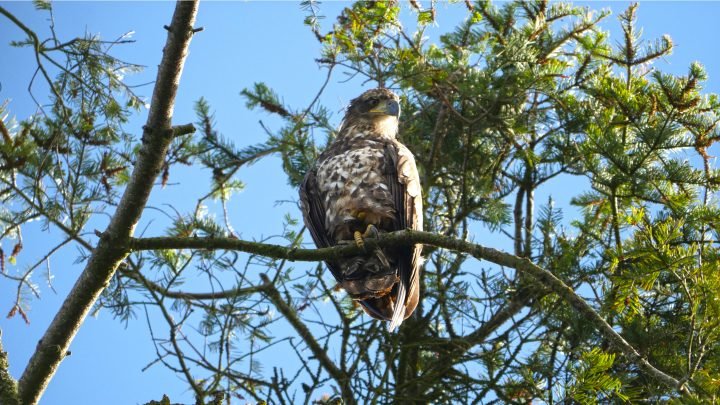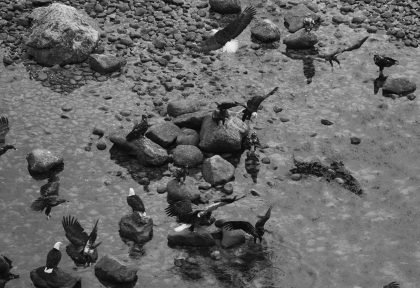
By Margot Griffiths
Point Roberts’ resident eagle expert, Jeff Butts, has long been fascinated by the magnificent birds that nest in our forests and fish off our shores. These five square miles have been called by another top eagle expert, Canada’s David Hancock, as the most significant eagle habitat in North America.
With that statistic, we are lucky we have Butts, who offers monthly information nights at the community center to help us coexist with eagles, whose habitat is under constant challenge from human
encroachment.
As a kid growing up in Portland on the Columbia River, Butts’ early interest was in raptors. He was 23  years old and running a successful construction company before he saw an eagle. “I was on South Beach in Point Roberts, when I saw this huge
years old and running a successful construction company before he saw an eagle. “I was on South Beach in Point Roberts, when I saw this huge
shadow.”
Twenty feet overhead was his first glimpse of what would become his life’s passion. Jeff’s roots in Point Roberts are deep – he is the great-grandson of George Waters, who established Waters Mercantile in 1896, and a nephew of Irene Waters – and throughout the years he has created many opportunities to get to know the eagles of Point Roberts.
Jeff was a film major at the University of Oregon and in 1999, he bought his first video camera. In the spring of 2000, at Lily Point, he got his first shot of an eagle. “I felt an instinctive awareness of how to act around an eagle. I got within 12 feet.” At 6'6", it seems to me Jeff really got within six feet. The thrill of that first connection never left him, and in 2007, Jeff started monitoring Point Roberts’ eagle population. “I quit my career in construction to live here. The eagles needed help.” In Washington state, eagles are protected by law, but “there’s no enforcement, no public education,” said Butts. Well, there is now, on the second Thursday of each month, at the community center.
“The key is learning how not to disturb them. Lily Point should be a sanctuary for eagles, but they’ve left due to all the human activity.” Now the eagles are ranging northward, between Lily Point and Maple Beach. Some days there are up to 50 eagles on the sandbars.
Given our good fortune to live among eagles, learning about them makes good sense. For instance, eagles have only enough calorie intake to fly for about 28 minutes a day. With a wingspan of 7 feet, think of the energy a 12- to 14-pound bird needs to flap those wings. They need their energy to hunt, so don’t approach one sitting on a telephone pole. Let it rest. When the wind is right, eagles can catch the thermal updrafts rising up the bluffs from South Beach to Maple Beach. To see this joyful, effortless soaring is to see an eagle at play.
Eagles feed first thing in the morning and late in the day. Seventy percent of their diet is fish, and with eight times the distance vision and five times the resolution of the human eye, an eagle can see a fish breaking the surface two miles away. Only about 25 percent make it to adulthood. “Juvenile eagles have it hard,” saidButts. “It takes years to develop the skills for deep water fishing.” The good news is, the low tides in Point Roberts provide easy pickings for young ones. “They come from all over the mainland to the low tides here. And standing on the sand is relaxing for eagles. They can ease their talons.”
“Eagles go where people aren’t,” Butts said, but added that eagles are like elephants. “They remember you, and become familiar with you, and if you’re sensitive to it, an eagle can learn to trust you. There are 11 nests on Point Roberts for sure and maybe a few more.” He is familiar with – and trusted by – each nesting pair.
According to Butts’ research, “Native Americans revered eagles and saw them as messengers from the gods. They believed eagles carried prayers to and from the Creator. The ancient Greeks and Romans believed eagles carried the souls of the departed to the gods.” Though today our sensibilities are more prosaic, it is hard not to feel a sense of exhilaration and wonder when in the presence of an eagle.
Butts has created a comprehensive website with videos, habitat and nesting information and live web cams. (The web cam that monitors the wellbeing of the nesting pair at Seabright is currently down, but Seabright staff are working on getting the eagle cam back up and online.)
With monthly meetings featuring pictures, videos and monitoring updates, Butts aims to heighten awareness of how human intrusion impacts the lives of these beautiful animals. Check it out, lend your support and become an eagle ally at eagleskyenet.com.
Comments
No comments on this item Please log in to comment by clicking here